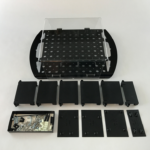Frequency bands within the electromagnetic spectrum have multiple, sometimes confusing, overlapping designations. Electronics engineers must deal with the electromagnetic spectrum as a routine part of their wired and wireless projects. This spectrum of interest ranges from relatively low frequencies in the kilohertz (kHz) range (or perhaps lower) into the tens and even hundreds of gigahertz […]
The why, where, and how of automatic gain control, Part 3
There are many ways to implement the automatic gain control function, which is critical to proper performance of many wireless and other links. The previous parts looked at the AGC in the context of its broadest application of wireless links. This part looks at some other aspects of AGCs. Q: What other applications use AGCs? […]
The why, where, and how of automatic gain control, Part 2
There are many ways to implement the automatic gain control function, critical to proper performance of many wireless and other links. The previous section discussed the context and need for AGC. This section will look at the different ways in which the AGC function is implements, and some of the parameters associated with the AGC […]
The why, where, and how of automatic gain control, Part 1
There are many ways to implement the automatic gain control function, which is critical to the proper performance of many wireless and other links. The automatic gain control function has been embedded in radio links since the earliest days of wireless technology, but the need for AGC is not limited solely to that application. Along […]
Have you considered resistance soldering? Part 2
Resistance soldering is an alternative to conventional “pencil” soldering iron, which offers unique capabilities. Resistance soldering is an easy-to-use alternative soldering technique that’s been available for decades and offers many benefits, although it cannot always be used when soldering is required. It leverages the well-known principle of electrical self-heating (I2R dissipation) to create a localized […]
Have you considered resistance soldering? Part 1
Resistance soldering is an alternative to conventional “pencil” soldering iron which offers some unique capabilities. The image of the electrical engineer or hacker bent over and using a soldering iron on a circuit board is a classic visual cliché of TV and movies (Figure 1). In most of these soldering images, the engineer is using […]
Digipots as electronic potentiometers, Pt 3: Enhancements
Digital potentiometers – digipots – are widely used, versatile, flexible, and feature-laden alternatives to classic mechanical potentiometers. In addition to their “hands-off” controllability, digipots offer additional simplicity, design-in ease, and much lower cost than potentiometers. Among their other capabilities: Dual digipots are useful where two resistances must be adjusted independently but especially so when they […]
Digipots as electronic potentiometers, Pt 2: Features
Digital potentiometers – digipots – are widely used, versatile, flexible, and feature-laden alternatives to classic mechanical potentiometers. In a traditional potentiometer, a person’s hand (or perhaps even a small motor) sets the wiper position and thus the voltage-division ratio. In a digipot, instead, a computer and digital interface connect to the digipot IC and establish […]
Digipots as electronic potentiometers, Pt 1: Differences
Digital potentiometers – digipots – are a widely used, versatile, flexible, and feature-laden alternative to classic mechanical potentiometers. Mechanical potentiometers are standard passive components that designers have used for decades in applications ranging from circuit trimming to volume control. However, they have their limitations: their wipers can wear out, they are susceptible to moisture ingress, […]
Breadboards evolve to meet 21st-century design needs, Part 3: The present and near future
The classic wooden breadboard is obsolete, but its name refers to a vital engineering tool that has changed to meet today’s component and design realities. Wooden breadboards are obsolete as platforms for circuits using modern components, of course, and so-called solderless breadboards are also of very limited usefulness. At the same time, the way designers […]









